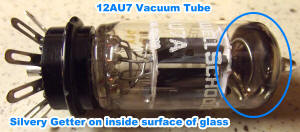Notes on the Getter
|
||
If you happen to be Estonian,
you might think of something entirely different than most RF Cafe visitors do when we hear
the word "getter." In fact, you probably capitalize the word since it is the name
of a pop singer from your country,
Getter Jaani.
If you are a child living in Japan, you would probably think of
Getter Robo, an anime from a popular cartoon series. I
suspect just about everyone
who visits RF Cafe knows getter as the silvery
deposit Notes on the Getter
In high-gain audio circuits, tube noises such as hiss and frying are some of the most troublesome things encountered. They can be eliminated only by selecting tubes which are inherently quieter or by reducing stage gain with negative feedback. In the latter instance gain might have to be reduced by such a factor as to defeat the original purpose. Hiss is created by DC resistance paths existing between various elements inside the tube. These leakage paths may be as high as 1,000 megohms and would not upset normal tube operation if they remained constant. But like a bad carbon resistor, they create noises of their own through random and erratic changes of resistance. Leakage paths of this sort are primarily located on the top mica support wafer, where the support rods are punched through. If the wafer is contaminated by impurities, it becomes a highly unstable conductor, connecting tube elements through very-high-resistance paths. Unfortunately, contamination of the wafer during tube manufacture is almost unavoidable. Before sealing the tube envelope, as much air as possible is exhausted by vacuum pumps, but a small percentage of oxygen and other gasses remain inside. This is where the getter comes into the picture. A small square loop of wire usually located at the top of the tube, part of it coated with an explosive substance similar to that used in photoflash bulbs. High-frequency radio waves penetrate the sealed envelope and heat the getter to a temperature high enough to fire this coating. This miniature explosion burns up the remaining atmospheric gasses inside the tube and, at the same time, splatters a mirror-like silver coating over a portion of the inner surface (a familiar sight in glass tubes). Some of this splatter falls on the mica wafer, making it slightly conductive. To reduce contamination of this sort, certain premium tubes are manufactured in which the space between getter and wafer is materially increased. In other types two top wafers are used - the upper one insulated from the lower - and act as an umbrella to receive most of the splatter. Another method is to punch oblong slots in the wafer. These openings effectively lengthen DC leakage paths and thereby reduce noise. In designing high-gain input stages for microphones and low-output pick-ups, it is desirable to use premium tubes whenever possible. Special manuals describing these types are published by tube manufacturers, giving electrical data, physical dimensions, recommended applications, etc. In many instances premium tubes are directly interchangeable with standard types which you might now be using. In addition to reducing hiss, premium tubes are less microphonic, have lower hum and are generally more dependable - and are more expensive.
Posted June 12, 2023 |
||



